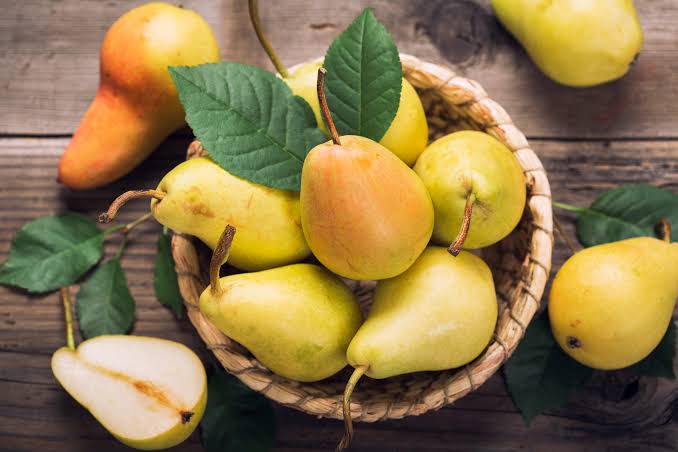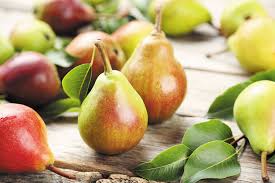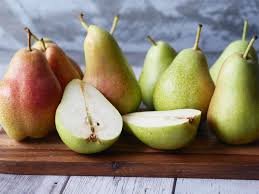Pears fruit which is scientifically known as Pyrus are delicious fruits that come in various shapes, sizes, and colors. They are a popular choice for a healthy and tasty snack. The smooth and slightly grainy texture of pears is one of the reasons many people enjoy eating them. These fruits belong to the Rosaceae family, just like apples and quinces.
One of the remarkable features of pears is their sweet taste. When you bite into a ripe pear, you’re greeted with a burst of natural sweetness that satisfies your taste buds. Pears can be enjoyed fresh, but they are also used in various culinary creations. From salads to desserts, pears add a delightful flavor and a touch of sweetness to many dishes.
Not only are pears delicious, but they also offer a range of health benefits. Pears are an excellent source of dietary fiber, which is essential for a healthy digestive system. Eating pears regularly can help prevent constipation and promote regular bowel movements. Additionally, the fiber in pears may contribute to a feeling of fullness, making them a great snack for those looking to manage their weight.
Pears also contain important vitamins and minerals. They are rich in vitamin C, which supports the immune system and helps the body absorb iron. The presence of antioxidants in pears further contributes to their health-promoting properties. These antioxidants may help protect the cells in your body from damage caused by free radicals.
One interesting aspect of pears is their versatility in the kitchen. They can be enjoyed in various forms – fresh, baked, poached, or even in jams and jellies. The natural sweetness of pears makes them a popular choice for desserts like pies and crisps. Baked pears with a sprinkle of cinnamon can be a delightful and simple treat.
Pears are not only tasty but also hydrating. They have a high water content, which makes them a refreshing choice, especially on a hot day. Including pears in your diet can contribute to your overall hydration, helping you maintain optimal health.
It’s worth noting that there are different varieties of pears, each with its own unique flavor profile. From the classic Bartlett pear to the Anjou and Bosc varieties, exploring different types of pears can be an enjoyable culinary adventure.
In addition, pears are not just fruits; they are a delightful combination of sweetness, texture, and health benefits. Whether you bite into a juicy, fresh pear or savor a baked pear dessert, you are indulging in a treat that not only pleases your taste buds but also contributes to your well-being. So, the next time you reach for a snack, consider grabbing a pear – nature’s delicious and nutritious gift.
Read Also: Swine Diseases and their Prevention Measures
History of Pears (Pyrus)

The history of pears dates back thousands of years, with evidence suggesting that these fruits have been enjoyed by humans since prehistoric times. Pears are believed to have originated in the region around the Caspian Sea and spread to various parts of the world through trade routes and human migration.
Ancient civilizations, including the Greeks and Romans, valued pears for both their taste and medicinal properties. The Romans even dedicated an entire chapter to pears in their agricultural manuscripts, emphasizing different varieties and cultivation techniques. Pears were cultivated in monasteries during the Middle Ages, further spreading their popularity across Europe.
During the Renaissance, pear cultivation experienced significant advancements. New varieties were developed, and the appreciation for these fruits grew among the upper classes. European explorers and colonists brought pear seeds to the Americas, contributing to the introduction of pears in North and South America.
In the 17th century, French and British horticulturists played a pivotal role in refining pear cultivation techniques. They developed methods for grafting and cultivating specific varieties, leading to the creation of numerous pear orchards. This period marked the beginning of systematic pear cultivation practices that continue to influence modern horticulture.
The 19th century witnessed the development of several notable pear varieties, such as the Bartlett pear in the United States and the Williams pear in England. These varieties became widely popular and are still cherished today for their unique flavors and textures.
The 20th century brought about advancements in fruit breeding and cultivation technology, further diversifying the world of pears. Commercial production increased, and pears became a staple in many households around the globe. With improved transportation, different pear varieties from various regions became accessible to consumers worldwide.
Today, pears are grown on almost every continent, with major producers including China, the United States, Argentina, and Italy. The continued cultivation, breeding, and global trade of pears highlight the enduring appeal and significance of these fruits throughout history. Whether enjoyed fresh, baked in pies, or processed into jams, pears remain a timeless and versatile component of human culinary history.
Nutritional Value of Pears (Pyrus)

Pears are not only delicious but also offer a range of essential nutrients that contribute to a healthy diet. Here’s a brief overview of the nutritional values of pears:
1. Calories: Pears are relatively low in calories, making them a suitable snack for those watching their calorie intake. A medium-sized pear typically contains around 100 calories.
2. Dietary Fiber: Pears are an excellent source of dietary fiber, particularly soluble fiber. Fiber aids in digestion, helps maintain bowel regularity, and may contribute to a feeling of fullness. A medium-sized pear can provide about 6 grams of fiber.
3. Vitamins: Pears are rich in various vitamins. They are a good source of vitamin C, an antioxidant that supports the immune system and promotes healthy skin. Pears also contain smaller amounts of other vitamins, including vitamin K, vitamin B6, and folate.
4. Minerals: Pears contain essential minerals, with potassium being a notable one. Potassium plays a crucial role in maintaining proper heart and muscle function. Pears also provide smaller amounts of minerals such as copper and magnesium.
5. Antioxidants: Pears contain antioxidants, which help protect cells from damage caused by free radicals. These antioxidants contribute to overall health and may have anti-inflammatory properties.
6. Natural Sugars: Pears contain natural sugars, including fructose. While they contribute to the fruit’s sweet taste, the natural sugars in pears come with the added benefit of fiber, which can help regulate blood sugar levels.
7. Water Content: Pears have a high water content, contributing to hydration. Staying hydrated is essential for overall health, and consuming water-rich fruits like pears can contribute to daily fluid intake.
It’s important to note that the exact nutritional content can vary slightly depending on the variety of pear and its ripeness. Additionally, consuming a variety of fruits and vegetables as part of a balanced diet is recommended to ensure a diverse range of nutrients.
Incorporating pears into your diet can be a tasty way to enjoy these nutritional benefits while satisfying your sweet cravings with a natural and wholesome treat.
Read Also: Neonatal Pig Diarrhoea: Clinical Signs, Prevention and Treatment
Health Benefits of Pears (Pyrus)

Pears offer a variety of health benefits, making them a nutritious addition to your diet. Here are some of the key advantages associated with consuming pears:
1. Digestive Health: Pears are an excellent source of dietary fiber, including both soluble and insoluble fibers. This fiber content promotes healthy digestion, helps prevent constipation, and supports regular bowel movements.
2. Heart Health: The potassium content in pears contributes to heart health by helping regulate blood pressure. Potassium is a vital mineral that supports proper cardiovascular function and reduces the risk of hypertension.
3. Weight Management: The fiber in pears can contribute to a feeling of fullness, potentially aiding in weight management. Including fiber-rich foods like pears in your diet may help control appetite and reduce overall calorie intake.
4. Immune System Support: Pears are a good source of vitamin C, an antioxidant that plays a crucial role in supporting the immune system. Regular consumption of vitamin C-rich foods, like pears, may help protect against infections and illnesses.
5. Antioxidant Protection: Pears contain various antioxidants, including flavonoids and carotenoids. These compounds help protect cells from oxidative stress, which is linked to aging and various chronic diseases.
6. Anti-Inflammatory Properties: Some compounds in pears have been associated with anti-inflammatory effects. Consuming foods with anti-inflammatory properties may contribute to overall health and potentially reduce the risk of chronic inflammatory conditions.
7. Hydration: Pears have a high water content, contributing to hydration. Staying well-hydrated is essential for overall health, supporting bodily functions and promoting healthy skin.
8. Blood Sugar Regulation: The natural sugars in pears, combined with their fiber content, can contribute to better blood sugar regulation. The fiber slows down the absorption of sugars, helping to prevent rapid spikes and crashes in blood glucose levels.
9. Bone Health: Pears contain small amounts of essential minerals like calcium and magnesium, contributing to bone health. These minerals play a role in maintaining bone density and preventing conditions such as osteoporosis.
10. Cancer Prevention: Some studies suggest that the antioxidants in pears may have cancer-fighting properties. While more research is needed, the presence of these compounds underscores the potential health benefits of including pears in a balanced diet.
Incorporating a variety of fruits, including pears, into your daily meals can contribute to a well-rounded and nutritious diet. As with any food, moderation and balance are key for optimizing health benefits.
How to Grow Pears (Growing Guide)
Growing pears can be a rewarding experience, whether you have a spacious backyard or a small garden. Here’s a basic guide on how to grow pears:
1. Choose the Right Pear Variety: There are various pear varieties, each with its own flavor and growing requirements. Select a variety that suits your climate and soil conditions. Common varieties include Bartlett, Anjou, Bosc, and Comice.
2. Planting: Pears prefer well-drained soil with a slightly acidic to neutral pH. Choose a sunny location for planting. Plant your pear tree in late winter or early spring when it is dormant.
Ensure proper spacing between trees to allow for good air circulation and sunlight exposure.
3. Soil Preparation: Prepare the soil by incorporating organic matter, such as compost. This helps improve soil structure, drainage, and nutrient content.
4. Planting Depth: When planting a pear tree, make sure to plant it at the same depth it was in the nursery. Avoid planting too deep, as this can hinder root development.
5. Watering: Provide consistent and deep watering, especially during dry periods. However, avoid waterlogged conditions, as pears are susceptible to root rot.
6. Fertilization: Fertilize your pear tree in early spring before new growth begins. Use a balanced fertilizer or one specifically formulated for fruit trees. Follow recommended application rates.
7. Pruning: Pruning is crucial for shaping the tree, improving air circulation, and promoting fruit production. Remove dead or diseased branches, and thin out crowded growth to allow sunlight to reach all parts of the tree.
8. Pollination: Pears are often not self-pollinating, so you’ll need at least two pear trees for cross-pollination. Make sure to choose varieties that flower at the same time for successful pollination.
9. Pest and Disease Management: Keep an eye out for common pests like aphids and codling moths. Use organic or chemical control methods as needed. Regularly inspect your tree for signs of diseases such as fire blight, and promptly address any issues.
10. Harvesting: Pears are typically harvested when they are mature but still firm. The exact time varies based on the pear variety. Check for color changes and firmness to determine ripeness.
11. Storage: Store harvested pears in a cool and dark place. Some varieties benefit from a short period of refrigeration to enhance flavor.
Remember, successful pear growing requires patience and consistent care. Be attentive to the needs of your pear tree throughout its growth stages, and you’ll likely be rewarded with a bountiful harvest of delicious and homegrown pears.
Read Also: Physic-Chemical Treatment Process
